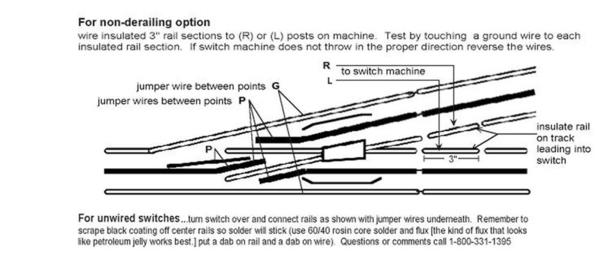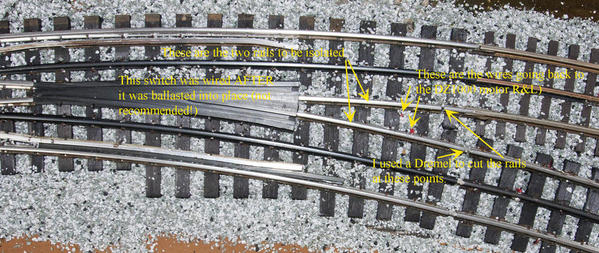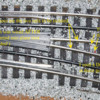Hi Mike:
“All that you need to do is solder the leads to the insulated rails and use an insulated rail joiner on the other end of that rail”.
Question 1. The leads you reference are those 3” sections identified in the picture by the ‘R & L to switch machine’ and also on the far rights side of the diagram.
Here's a picture of one of my switches. (Click on it for full size). The insulated rails are identified, as are the cuts I made in them to isolate them. It is preferable to use insulated rail joiners but this particular switch was wired for de-rail AFTER it was already ballasted firmly into place and I could not use rail joiners. So I just cut the rails to isolate them.
Question 2. Those leads get soldered to the R & L posts on the switch machine. This requires wires to go under the table & back up again to connect to the switch machine, correct ?
I used wire nuts to connect the DZ1000 motors to track voltage. The leads were simply added to the appropriate power wire. If you get them backwards, and the switch moves the wrong way, simply reverse them.
Question 3. Where is the “other end of that rail” you reference ? Can you please identify that for me.
One "end" of the insulated rail butts against the black plastic part of the switch and is therefore, insulated at that end already. The "other" end can actually be anywhere you choose to make the cut. Or make no cut and just use an insulated rail joiner placed at any joint. Again, in the picture, this switch was already firmly in place and I had to cut the rails.
For a switch not yet cemented in place you could use an insulated rail joiner placed at any track joint on the rail, either at the switch itself, or further away from it.
Question 4. If need be, where would you cut the rail for a longer insulated section ? Would it be one of the center rails on the right side of the picture (the 2 track end) or the left single track side.
Hope the picture and the above paragraph make that clear? No center rail is ever cut for this feature! Only the two rails shown in the image are insulated!
Question 5. Does the non de-rail work no matter which direction the train is coming from ? Would the center rail need to be cut on both sides of the switch ?
Yes, the feature works on both the non-diversion and the diversion route. Again though, no center rail is ever cut! Also only the side of the switch shown in the image is changed for this operation. The other end of the switch, not shown at all in the image, is not affected or changed in any way. Just connect it to the track normally. ONLY TWO RAILS ARE EVER INVOLVED HERE! Never the center rail and never more than the two COMMON RAILS INDICATED IN THE IMAGE! The other common rails are also not affected or changed in any way.
Hope this clears it up? This is not a difficult procedure. Most complicated part of it is soldering the leads to the insulated rail sections.









